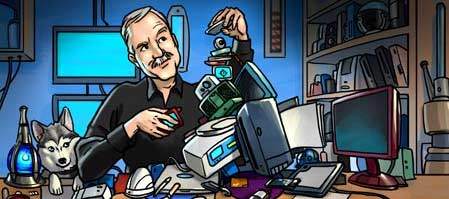Like a lot of technophiles, I watched the keynote given by Microsoft CEO Steve Ballmer to officially kick off CES. While I’m sure MS managed to pack the room, there was little you could take away that most didn’t already know.
Frankly, the reviews haven’t been great. This is probably due to a number of issues, but first and foremost, the opening keynote at a show like CES should definitely be given by a visionary. Once upon a time, Bill Gates was that visionary. Even on a good day Steve Ballmer can’t exactly be described as one, and so the current Microsoft CEO is a poor choice to keynote CES or any other forward looking show.

I think this highlights an endemic problem at events like CES, which traditionally pick speakers based on their job title and financial resources, rather than skillset.
This effectively kills the entire concept of what a real “keynote” talk should be. For some reason, the “keynotes” at many shows have become little more than utterly transparent product pitches. As a result, most are incredibly disappointing.
Steve Ballmer
First, since I’ve been outspoken about Steve Ballmer going up on stage with a stick up his butt and acting like a Stepford CEO, I’d like to clarify by saying he was natural on stage this time. Actually, the problem wasn’t his performance, as Ballmer had lots of energy, didn’t miss a mark and appeared relaxed and well-rehearsed.
Still, a common problem with many CEOs is that they like to alter their prepared speeches at the last minute or don’t rehearse well. They then stumble through their speech using a prompter or worse, lose their way reading boilerplate PowerPoint slides. Essentially, the issue at MS CES keynote wasn’t performance (at least not the moderator’s or Ballmer’s). True, one speaker had trouble catching her breath and that was clearly a practice issue, and even some of us more experienced folks (me for instance) do this from time to time. But content, particularly for a major CES keynote, was light.
Bill Gates
Bill was never a great speaker but he did have incredible vision. There was always some aspect of looking towards the future in his keynotes that made the talk worthwhile – even though he too had a lot of product content. His last shared vision, and unique sense of humor, was on the concept of multiple screens – including phones, PCs and TVs. Both Google and Microsoft are now executing that very vision which has expanded to include screens in cars, while flirting with displays on mundane devices such as refrigerators.
When Bill left Microsoft he anointed Ray Ozzie as his replacement – but Ray was forced out some time ago and, and as an outsider, was never able to really drive his vision in Redmond. Ray’s skillset was tied to small teams and he rarely, if ever, warmed to the unique politics inside of Microsoft.
So what made Bill a good choice for the CES opening keynote? Not that he was Microsoft’s CEO, but rather, Gates was Microsoft’s visionary. Unfortunately, it is precisely the current lack of vision at Redmond that is hurting the company’s future.
CES vs. Comdex: Products vs. Vision
Both Comdex, which ultimately became extinct, and CES suffer from a core problem: convicing vendors to financially support the show – thereby prompting both venues to grow to unsustainable sizes.
This means CES probably should evolve into more of a small vendor show, either focusing more tightly on the first half of the year – or shift a few months later so it can do a better job as a fall venue. This might solve the keynote problem as well, simply because you typically don’t perceive visionaries to be CEOs of large companies unless they founded them.
Think about it: visionaries establish startups, while folks who aren’t trundle off to work for large companies. So, if you want to make keynotes interesting and drive a more lucrative future for an industry, such addresses should really be highlighted by individuals who have and are capable of sharing their vision.
The little guys are working on the next Siri, or Eyeball interfaces, personal drones, or the next generation of motion technology. Yes, they can talk products – but because the lineups are new and fresh they are forced to talk about a future world where such things will be useful. Essentially, the little guys can do product pitches that are visionary because they are still in an early stage with their companies.
Granted, I’d still like to see a vendor independent visionary talk about the future without a product pitch at least once, but I think getting the large vendors off the stage and the little guys back on would do a lot to drive excitement and move the US consumer industry back into the lead.
Wrapping Up: Putting the “Key” back in Keynote
In the end, and this is hardly just a CES problem, people putting on shows really should go back and think about what a keynote is supposed to be. A product pitch is a specific kind of talk and, as we all know, Steve Jobs was the best at doing this type of pitch.
In contrast, a keynote is supposed to set the tone for an event, establish a common thread, while capturing the major themes and trends. Without an inspiring keynote, all you have is a rowdy public marketplace with screaming product managers trying to drown each other out. Of course, the biggest companies have the loudest voice, and so attendees can’t help but wonder when the pain will end.






